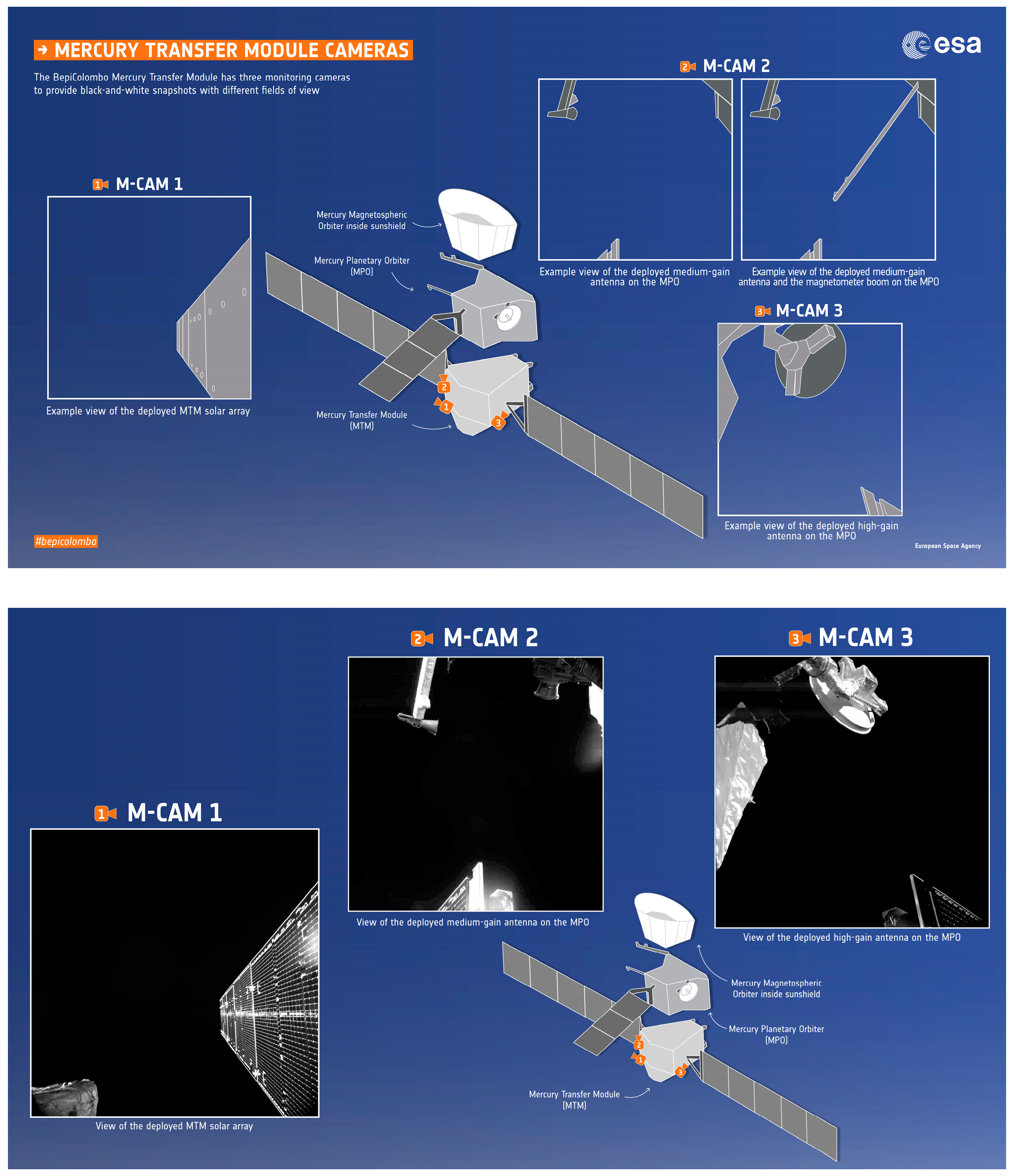Driven by the constantly evolving and iterative SWaP3, manufacturers have focused on some advanced directions such as miniaturization, lightweight, high performance (high-resolution, hyperspectral), and intelligence of IRCs. In applications such as surveillance globalization satellites and much strategic military equipment, the requirement for performance is unlimited. Additionally, the focus of scenarios dominated by high performance is to improve time resolution, spatial resolution, spectral resolution, and other core performance parameters such as sensitivity, frame rate, signal-to-noise ratio, as well as the degree of intelligence of the imaging devices.
- infrared camera
- intelligent
- SWaP3
1. Introduction

| Development/ On-Board Deployment Time |
Camera Name | Institution/ Company |
Band | Scenes | Size, Weight, Power | Solution | Cooled or Not (Y/N) |
Highlighting Technology |
|---|---|---|---|---|---|---|---|---|
| 2010 | Chang’e-2 Advanced Photo System’s (APS) landing camera [9] | Beijing Institute of Space Mechanics & Electricity (BISME) | VNIR | Satellite surface imaging | Size: 100 × 80 × 81 mm3 Weight: 502 g Power: 4 W |
1280 × 1024 640 × 512 |
N | Dual mode: High resolution and high frame rate mode |
| 2011 | ATOM1024 XGA | Sofradr EC | LWIR | Large FOV, situation awareness, surveillance | Size: 61 × 69 × 66 mm3 Weight: <110 g Power: <3.7 W |
1024 × 768 | N | Uncooled micro-radiometer camera wide detection range |
| 2013 | Tamarisk 320 Cameras |
DRS | LWIR | High sensitivity and high image quality requirements | Size: <34 × 30 × 30 mm3 Weight: <37 g Power: <1.1 W |
320 × 240 | N | With non-uniform correction, real-time video processing |
| 2013 | Tamarisk 640 Cameras |
DRS | LWIR | High sensitivity and high image quality requirements | Size: 46 × 40 × 31 mm3 Weight: <73 g Power: <1.5 W |
640 × 480 | N | With non-uniform correction, real-time video processing |
| 2014 | Banpil Camera | Banpil Photonics | VIS-SWIR Multispectral |
Identification and detection in all weather and visibility conditions | Size: Not mentioned Weight: Not mentioned Power: <1 W |
640 × 512 | N | Low dark current Multispectral imaging High-performance FPA HDR |
| 2015 | SMART Chip Camera |
BAE Systems | LWIR | Edge scenarios such as handheld | Size: 2.9 cm3 Weight: 5.1 g Power: <0.5 mW |
640 × 480 1280 × 1024 |
N | “SMART” Architecture Android GUI |
| 2016 | TEC-less SWIR Camera | UTC Aerospace Systems | SWIR | Various scenarios requiring SWIR | Size: Not mentioned Weight: Not mentioned Power: <1.4 W |
1280 × 1024 | N | no TEC Current mirror-type pixel |
| 2016 | Hot Blackbird XBn detector | SCD | MWIR | Surveillance, missile warning | Size: Not mentioned Weight: 730 g Power: 7.5 W |
1920 × 1536 | Y | 10 μm small pixel size Smaller cooled device |
| 2018 | SWIR Imager based on Cardinal 640 | SCD | SWIR | Day and night imaging: strong daylight and LLL | Size: 31 × 31 × 32 mm3 Weight: 50 g Power: <1.3 W |
640 × 512 | Y | Video engine image processing algorithm HDR LLL High Adaptation |
| 2018 | FLIR Tau 2+ [10] |
TELEDYNE FLIR | LWIR | In-orbit observation | Size: 82 × 82 × 145.08 mm3 Weight: 422.8 g Power: <1.2 W |
640 × 512 | N | High sensitivity Multiple video formats |
| 2018 | CIRES cameras [10] |
TELEDYNE e2v | VNIR | In-orbit observation | Size: 40.8 × 36.6 × 34.1 mm3 Weight: 70 g Power: 1.5 W |
1280 × 1024 | N | Multi-image processing algorithms High frame rate |
| 2018 | MCAMv3 camera | microcameras.space | VNIR | In-orbit monitoring on solar panels and critical loads | Size: 63.1 × 45 × 85 mm3 Weight: 327 g Power: <1.8 W |
4 million | N | Embedded image compression High Resolution HDR |
| 2020 | HyperScout 2 | Cosine | VNIR/LWIR Hyperspectral |
Fire detection, heat island effect, etc. | Size: 1.8 L Weight: 1.8 kg Power: 11 W |
4000 × 1850/1024 × 768 | N | VNIR/TIR Dual channel Hyperspectral/AI Chip BEE/OBDH Subsystem |
| 2021 | Griffin-5 HOT MWIR | Attollo Engineering | MWIR | MWIR edge scenario | Size: 166 cm3 Weight: 250 g Power: <4 W Power with cooling: <10 W |
640 × 512 | Y | 5 μm small pixel pitch sensor |
| 2022 | HyperScout M | Cosine | VNIR Hyperspectral |
Fire detection, heat island effect, etc. | Size: 1.2 L Weight: 1.2 kg Power: 9 W |
4096 × 1850 | N | Hyperspectral AI Chip BEE/OBDH Subsystem |
| 2022 | Griffin-8 HD | Attollo Engineering | SWIR/MWIR dual Band | SWIR and MWIR edge scenarios | Size: 97 × 50 × 50 mm3 Weight: <250 g Power: <6 W Power with cooling: <10 W |
1280 × 720 | Y | 8 μm small pixel pitch sensor |
| 2022 | Multi-Mode Tracking (MMT) Camera | Collins Aerospace | SWIR | Multimodal scenes | Size: 25 × 25 × 7 mm3 Weight: Not mentioned Power: 1.5 W |
1280 × 1024 | Not mentioned | Multimode: Support passive and ALPD active imaging |
2. Applications
2.1. Military and Scientific Field

2.2. Civil Field
This entry is adapted from the peer-reviewed paper 10.3390/s23094189
References
- Ye, Z.; Chen, Y.; Zhang, P. Overview of latest technologies of HgCdTe infrared photoelectric detectors. Infrared Technol. 2014, 35, 8.
- Mai, L. Outline on development and application of FPA thermal imaging sets. Infrared Technol. 2006, 28, 497–502.
- Pan, C.; Cang, L.; Luo, M.; Tao, L.; Chen, S.; Chen, B.; Bai, Z.; Cui, H.; Xu, C.; Zhao, J. Development status and application of space infrared camera optical technology. Infrared Technol. 2022, 44, 9.
- Jiao, B. Status and trends of development of satellite-based compact CCD cameras. Space Electron. 1995, 7, 34–40.
- Ye, Z.; Li, H.; Wang, J.; Chen, X.; Sun, C.; Liao, Q.; Huang, A.; Li, H.; Zhou, S.; Lin, J. Recent hotspots and innovative trends of infrared photon detectors. J. Infrared Millim. Waves 2022, 41, 15–39.
- Dhar, N.K.; Elizondo, L.A.; Dat, R.; Elizondo, S.L. Advanced imaging systems programs at DARPA MTO. In Proceedings of the Infrared Sensors, Devices, and Applications III, San Diego, CA, USA, 19 September 2013; p. 886802.
- Li, C.; Han, C.; Skidmore, G.D.; Cook, G.; Kubala, K.; Bates, R.; Temple, D.; Lannon, J.; Hilton, A.; Glukh, K. Low-cost uncooled VOx infrared camera development. In Proceedings of the Infrared Technology and Applications XXXIX, Baltimore, MD, USA, 29 April–3 May 2013; pp. 465–474.
- Sengupta, L.; Auroux, P.-A.; McManus, D.; Harris, D.A.; Blackwell, R.J.; Bryant, J.; Boal, M.; Binkerd, E. BAE systems’ SMART chip camera FPA development. In Proceedings of the Infrared Technology and Applications XLI, Baltimore, MD, USA, 8 June 2015; pp. 338–344.
- Yue, T.; Zhang, H.; Huang, C.; Chen, X. The application of Chang’ E-2 CMOS camera technologies. Space Recovery Remote Sens. 2011, 32, 12–17.
- Pack, D.; Ardila, D.; Herman, E.; Rowen, D.; Welle, R.; Wiktorowicz, S.; Hattersley, B. Two aerospace corporation CubeSat remote sensing imagers: CUMULOS and R3. In Proceedings of the 31st Annual AIAA/USU Conference on Small Satellites, Logan, UT, USA, 4–10 August 2017.
- Schulz, R.; Benkhoff, J. BepiColombo: Payload and mission updates. Adv. Space Res. 2006, 38, 572–577.
- Benkhoff, J.; Van Casteren, J.; Hayakawa, H.; Fujimoto, M.; Laakso, H.; Novara, M.; Ferri, P.; Middleton, H.R.; Ziethe, R. BepiColombo—Comprehensive exploration of Mercury: Mission overview and science goals. Planet. Space Sci. 2010, 58, 2–20.
- Benkhoff, J.; Murakami, G.; Baumjohann, W.; Besse, S.; Bunce, E.; Casale, M.; Cremosese, G.; Glassmeier, K.-H.; Hayakawa, H.; Heyner, D. BepiColombo-mission overview and science goals. Space Sci. Rev. 2021, 217, 90.
- Krag, H.; Serrano, M.; Braun, V.; Kuchynka, P.; Catania, M.; Siminski, J.; Schimmerohn, M.; Marc, X.; Kuijper, D.; Shurmer, I. A 1 cm space debris impact onto the sentinel-1a solar array. Acta Astronaut. 2017, 137, 434–443.
- ESA. BepiColombo Monitoring Cameras. Available online: https://www.esa.int/ESA_Multimedia/Images/2018/10/BepiColombo_monitoring_cameras (accessed on 21 March 2023).
- ESA. BepiColombo’s first images from space. Available online: https://www.esa.int/ESA_Multimedia/Images/2018/10/BepiColombo_s_first_images_from_space (accessed on 21 March 2023).
- Li, F. Development of small infrared camera on board. Space Recovery Remote Sens. 2004, 25, 5.
- Thangavelautham, J.; Asphaug, E.; Dektor, G.; Kenia, N.; Uglietta, J.; Ichikawa, S.; Choudhari, A.; Herreras-Martinez, M.; Schwartz, S. An Interplanetary CubeSat Mission to Phobos. In Proceedings of the 48th Annual Lunar and Planetary Science Conference, The Woodlands, TX, USA, 20–24 March 2017; p. 1707.
- Schwartz, S.; Nallapu, R.T.; Gankidi, P.; Dektor, G.; Thangavelautham, J. Navigating to Small-Bodies Using Small Satellites. In Proceedings of the 2018 IEEE/ION Position, Location and Navigation Symposium (PLANS), Monterey, CA, USA, 23–26 April 2018.
- Huawei. Available online: https://www.huawei.com (accessed on 21 March 2023).
- Unispectral. Available online: https://www.unispectral.com/product/monarch-nir-pcb/ (accessed on 21 March 2023).
